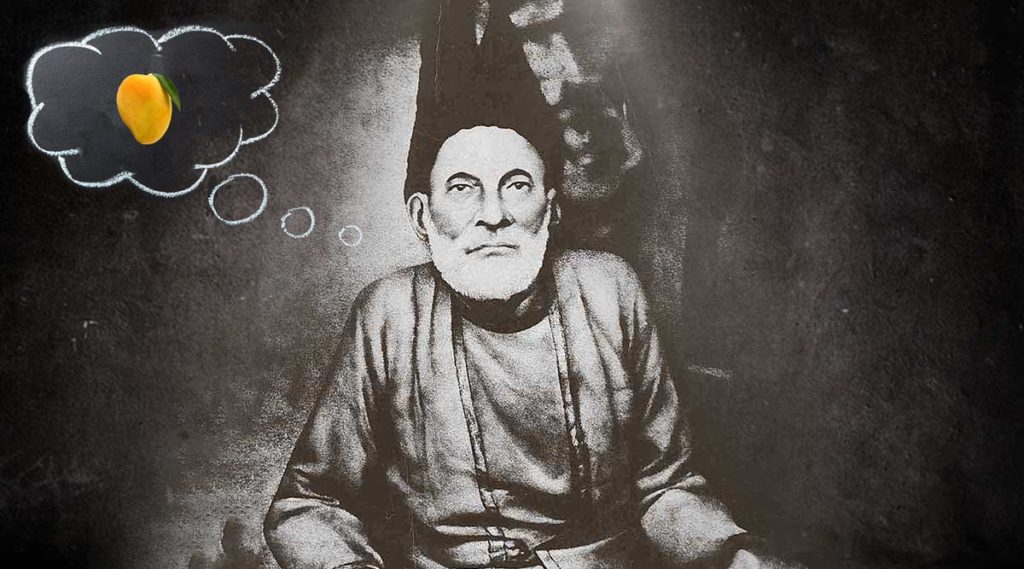
Mirza Asadullah Khan Ghalib or Mirza Ghalib as he is commonly known, has a well-deserved reputation as a mango-lover extraordinaire. If you thought you loved mangoes, wait till you hear this!
There was this one time Maulana Faizal-e-Haque along with others had congregated and were discussing mangoes. Ghalib too was present there and when he was asked about his passion for mangoes, the poet replied,
(Mangoes need to have two qualities, they need to be sweet and there needs to be plenty.)
One only has to go through his letters to realise that his passion for mangoes crosses the line into obsession. He often wrote about his mango exploits in missives to his friends.
Here’s the list of some of Ghalibs favourite mangoes arranged in alphabetical order. Just try to imagine what some of the unfamiliar ones taste like.
Alphonso, Aziz-Pasand, Baadaami, Baaraah Maasi, Bishop, Bombay Green, Chausa, Dasehri, Dil-Pasand, Fajri Samar Bahisht, Fasli, Gulaabakhsh, Hamlet, Husn-aara, Jahaangir, Kishan Bhog, Khatta Meetha, Khudaadaad, Langra, Mahmood Samar, Malda, Malghoba, Naazuk-Pasand, Neelam, Nishaati, Ramkela, Ratol, Rahmat-e-Khaas, Roomaani, Safeda, Sarauli, Sinduri, Sultan-us-Samar, Totapari, Xavier, Zaafraani, Zard Aaloo.
What qualities does a mango have to possess to be called Naazuk-Pasand (one preferred by the delicate)? Or Rahmat-e-Khaas (a special grace)? What on earth is a Hamlet? Is the Baaraah Maasi really available twelve months a year? Who in their right minds would name a mango Zard Aaloo (yellow potato)?
However, Ghalib’s love for mangoes did not end there. There was this one time the poet was out on a stroll with the Mughal emperor Bahadur Shah Zafar when they came upon the mango orchard of Baagh-e Hayaat Bakhsh at Lal Qila(Red Fort), whose fruit was reserved for the nobility. Zafar noticed that Ghalib was looking intently at one of the trees which were particularly laden with fruit. Perturbed, the emperor asked him why he was staring at the tree.”
Ghalib is said to have replied,
“Badshaah salamat maine buzurgo se suna hai,/ Daane Daane pe likha hai Khaane waale ka naam. Ibn falon ka naam, ibn falon ka naam… Dekh raha hoon kisi aam pr mere baap dada ka naam bhi likha hai kya.”
The emperor understood what Ghalib wanted and sent him baskets full of mangoes from that orchard that very same day.
Ghalib’s mango-philia is so strong that he is not averse to humbling himself for a chance to be gifted the fruit. In a letter addressed to the caretaker of Calcutta’s Imambara, he writes ingratiatingly: “Not only am I a slave to my stomach I am a weak person as well. I desire that my table be adorned and that my soul be comforted. The wise ones know that both of these cravings can be satisfied by mangoes.”
As a 60-year-old, he laments in a letter that he can no longer eat “more than ten or twelve at a sitting… and if they are large ones, then a mere six or seven. Alas, the days of youth have come to an end, indeed, the days of life itself have come to an end.”
It’s hardly surprising then that Ghalib composed a masnavi titled dar sifat-e ambaah (On the Attributes of Mangoes), which included lines such as:
aam ke aage neyshakar kya hai…
ya ye hoga ke fart-e rafa’at se
baagh-baanoñ ne baagh-e jannat se
angabeeñ ke, ba hukm-e rabb-in-naas
bhar ke bheje haiñ sar-ba-mohr gilaasask me! for what do you know?
a mango is far sweeter than sugarcane…
perhaps from the great heights above
the gardeners of heaven’s orchards
have sent, by the order of God
wine filled in sealed glasses
Still think you’re the biggest mango lover out there? Try out some of Ghalibs favourite mangoes and dozens of varieties of freshly harvested, naturally ripened organic mangoes on the Farmizen app and vicariously re-live his obsession!


Comment